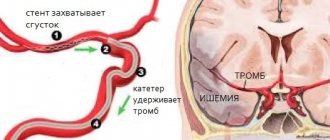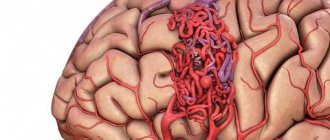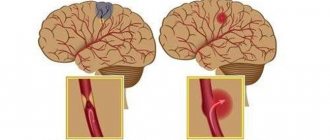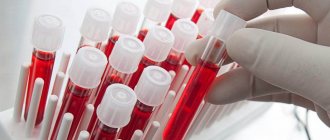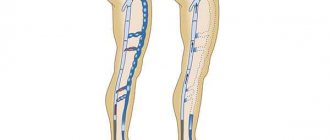Varicose veins, or varicose veins of the lower extremities, is a disease characterized by disruption of the venous valves and is caused by congenital weakness of the vascular wall, which leads to stagnation of blood in the veins of the lower extremities. Varicose veins of the lower extremities are accompanied not only by impaired blood supply and tissue nutrition, which can result in various problems in the form of congestive allergic skin irritations and the occurrence of difficult-to-heal trophic ulcers, but it is also dangerous because slow-flowing blood is prone to the formation of blood clots that can close the lumen of any vessel in the body. If the inflammatory process joins and passes to the venous wall, thrombophlebitis develops, and venous blood flow in the limb is disrupted.
People have been suffering from varicose veins of the lower extremities since ancient times. For many years, doctors wanted to alleviate the suffering of patients and tried various methods to treat this pathology. In Ancient Egypt, mummies showed signs of varicose veins and traces of burns in their place - Egyptian aesculapians used cauterization to treat varicose veins.
In Ancient Greece, Herophilus and Erasistratus described the location of human veins and presented a diagram of the entire vascular bed, and Hippocrates was the first to puncture a varicose vein and present one of the methods of conservative treatment of varicose veins of the lower extremities - local compression of the dilated vessel. Avicenna (980–1037) was the first to propose bandaging limbs for varicose veins. In India and China, at that time the most cultural and progressive centers of the world, they developed preventive exercises, the use of leeches, herbal medicines that thin the blood, contrast baths, and therapeutic nutrition.
In the 17th-19th centuries. Medical science developed rapidly, the advent of the microscope helped to study capillary blood flow and the etiology of varicose veins of the lower extremities. Her treatment began to be guided by scientifically based concepts. Since the end of the 19th century, the development of phlebology began as an independent direction in surgery. The practice of surgeons included methods of surgical treatment that are still used today. The most common intervention for varicose vein disease was the Troyanov-Trendelenburg operation, which consists of ligating the great saphenous vein in the groin; this operation was often supplemented with traumatic incisions on the legs and thighs, trying to ligate or excise damaged saphenous veins.
The principle of thermal ablation of a vein to stop blood flow in it has been used since the 50s of the 19th century. Endovasal electrocoagulation, an analogue of modern laser coagulation (EVLC), as a method of excluding varicose veins from the blood circulation, was tested and proposed for use by Czechoslovak doctors K.Firt, L.Heigal, D.Jrivora in 1959. Instead of removing the vein, they treated the inner surface of the vein with current; the burn caused by the electrode led to scarring of the vein and its ablation (gluing).
Viktor Sergeevich Savelyev played a great role in the development, determination of indications and scientific substantiation of surgical methods for the prevention of pulmonary embolism. He introduced into clinical practice modern medical procedures for the successful treatment of venous trophic ulcers and a vena cava filter to retain detached blood clots.
Get an online consultation
right now.
Get
Sclerotherapy as a method of treating varicose veins has been known since the beginning of the 20th century. This procedure is performed on an outpatient basis. The phlebologist uses a sclerosing drug to prepare foam, which is injected into the lumen of the vessel. Foam displaces blood from the vein and sticks its walls together. Over time, the sclerotic portion of the vein resolves. Compression stockings are placed on the leg and must be worn for 3-4 weeks.
As for the surgical treatment of varicose veins, phlebologists have a large number of techniques, procedures, and operations in their arsenal. In addition, modern instruments and equipment allow you to make the right decision in choosing surgical treatment, taking into account the cost of laser surgery for varicose veins.
In that version of varicose veins, when the saphenous vein is affected, it is correctly called the great saphenous vein, an operation is performed - combined phlebectomy, it is still used, and the technique for its implementation is as follows: two small incisions are made: in the groin and at the level of the ankle. A special probe is inserted into the vein, which is inserted along the entire length of the vein from the ankle to the groin, after which the vein is removed using this probe. The operation is performed in a medical center under spinal anesthesia and requires observation of the patient in the hospital for 24 hours.
Another operation is performed for tributary varicose veins; the indication for it is damage to small-diameter veins that bring blood to the main vein. In this situation, the altered vessels are removed through punctures that are brought out with special hooks, the veins are not ligated, and sutures are not placed on the skin. The puncture is sealed with an aseptic sticker. There are practically no puncture marks left. This operation is called miniphlebectomy and is performed on an outpatient basis under local anesthesia.
The most modern method is laser surgery to remove varicose veins. The operation is performed under local anesthesia; if the patient wishes, general anesthesia is performed. The essence of the operation is as follows: through a puncture in the shin area, a thin laser probe is inserted through a catheter into the lumen of the great saphenous vein to the point where it flows into the femoral vein. This procedure is performed under ultrasound guidance. After this, a hydraulic cushion is created around the vein, along its entire length, with a novocaine solution. The point of the pillow is that when laser exposure is applied to the wall of a vessel, the temperature in the surrounding tissues rises, the layer of liquid around the vein reduces the temperature effect on the tissues adjacent to it, in addition, novocaine acts as an anesthetic. Therefore, the purpose of the hydrocushion is to protect the tissue around the vein from burns that can result from laser energy, and at the same time anesthetize the surgical field.
After this, the laser is turned on and the inner walls of the vessel are treated with it. The power, pulse frequency and laser exposure time are calculated based on the data of each patient. As a result, the walls of the vein are deformed, stick together and form a dense cord. After 6-12 months, the vein resolves and the cord disappears. This laser operation for varicose veins of the lower extremities is called Endovasal Laser Coagulation (ablation), abbreviated as EVLT or EVLA.
Any operation, including laser surgery for varicose veins, requires preoperative examination and preparation. In terms of examination, it is necessary, in addition to duplex scanning of the veins, to take a test for infections and sugar, general and biochemical blood tests, conduct a study of the blood coagulation system, fluorography, and an electrocardiogram. People in the older age group are prescribed ultrasound examination of the heart (heart echo), ultrasound examination of the carotid arteries. Anyone planning laser surgery to remove varicose veins should be examined by a therapist and an anesthesiologist. On the eve of the operation, it is necessary to take a shower, shave the hair in the groin and along the inner surfaces of the legs and thighs, in the area of the intended surgical intervention. On the morning of the operation, you should not eat or drink water. You can only rinse in your mouth.
After the operation, compression garments of class 2 compression are put on everyone’s legs. We recommend leaving the stockings on for three days, and then putting them on only during the day and taking them off at night. In total, stockings need to be worn for 7 days. If the operation was performed under spinal anesthesia, then after 4-5 hours the sensitivity in the legs is completely restored, and the patient can go home on his own. If laser surgery for varicose veins in the legs was performed under local anesthesia, the patient can go home within an hour.
Modern laser treatment of varicose veins (“sealing” the vein)
Modern laser treatment of varicose veins in Moscow in our center is carried out using local anesthesia (without anesthesia) under constant ultrasound monitoring. Today, laser coagulation (EVLC) is the leading innovative method for treating varicose veins.
Doctor Semenov A.Yu. performs laser treatment of varicose veins - without a scalpel or incisions
Thanks to continuous ultrasound scanning during the procedure, the possibility of damage to healthy vessels and surrounding tissues is excluded. Incisions are not used at all during the laser obliteration procedure. After local anesthesia, a vein is punctured using a special needle. A laser light guide is inserted into the lumen of the vessel.
A laser light guide is inserted into the lumen of the diseased vein.
Under the control of ultrasound scanning, tumescent anesthesia is performed, the vein is delimited from the surrounding tissues and compressed. After completion of the administration of tumescent anesthesia, the process of thermoobliteration (sealing) of the venous vessel begins. The laser acts specifically on the vein wall; the surrounding tissues are not heated or damaged. The intensity and density of laser radiation is determined by the operator of the procedure. Therefore, it is important that the process is supervised by an experienced specialist. Our center uses only the best endovenous laser technologies. Today, the most modern technology for endovenous thermal treatment is a laser with a wavelength of 1940 nm.
Treatment of varicose veins with a laser generator with a new wavelength of 1940 nm
In Europe, Russia and the USA, according to leading experts, this technique is recognized as superior in thermal efficiency to previous laser generation.
The duration of the procedure is from half an hour to an hour and a half, sometimes more in advanced cases of varicose veins. After its completion, the staff of the phlebological center puts special compression hosiery on the patient’s legs, and within a few minutes the patient can leave the clinic.
Artem Yuryevich demonstrates German knitwear
The minimal surgical trauma characteristic of this treatment method allows the rehabilitation period to be reduced to almost zero.
Nevertheless, after this innovative treatment, the following rules must be observed, they are quite simple:
- Walking immediately after the intervention, about 2-3 km. Subsequently, such walks must be taken daily for 3-4 weeks.
- You should refrain from heavy exercise in the gym, as well as baths and saunas for 1.5-2 months.
- It is necessary to use the compression stockings prescribed by the doctor for about 3-4 weeks.
These are all the necessary requirements after a laser procedure at the Moscow City Phlebology Center. As we can see, modern laser intervention does not require a significant change in the usual lifestyle.
Can everyone have leg veins removed with a laser?
EVLT is an effective procedure that is well tolerated by patients and does not require a hospital stay. Most patients can undergo this treatment, but not all. In particular, if the lumen of the vein is very wide, then laser treatment of varicose veins may be ineffective; it is better to remove such vessels during surgery. EVLT is also contraindicated during pregnancy and lactation, if it is not possible to maintain an active motor mode after the procedure. In addition, there are certain restrictions for patients with cancer, inflammatory processes in the veins, and thrombophilia.
An additional obstacle to EVLT is the inability to wear compression stockings, which must be done after laser treatment of veins. For example, it is difficult and sometimes impossible to choose knitwear for a high degree of obesity; patients with atherosclerosis should not wear knitwear, etc. But in general, there are few absolute contraindications to EVLT.
It is believed that EVLT is a very simple procedure and after it you can immediately return to your normal lifestyle.
For example, do EVLT and return to work. Is it so? EVLT does not require a hospital stay, but this does not mean that the patient does not have to comply with some mandatory conditions. In particular, wear compression stockings around the clock for the first few days, then only during the daytime. And of course, move: if after EVLT you immediately return to sedentary work and spend 8 hours a day in one position, complications may develop, the risk of which is minimal if all recommendations are followed.
Significant advantages of laser treatment technology for varicose veins:
- minimal, in comparison with other methods, the number of side effects and complications;
- high cosmetic result;
- comfort of the procedure;
- mild, not disturbing the usual way of life, postoperative period;
- The efficiency of thermoobliteration is higher than that of competitors.
In experienced hands, the treatment result is 100%. Today there is no method of treating varicose veins that is as effective as laser endovenous obliteration.
Laser treatment of varicose veins in Moscow at the center of Dr. Semenov A.Yu.
The above makes modern laser obliteration the best method today for combating varicose veins not only in Moscow, but in the rest of Russia and Europe. However, even in Moscow, if the doctor lacks proper experience, the results of thermoobliteration can be ambiguous. A good specialist with the proper experience takes into account many factors that can affect the outcome of the intervention:
- features of the anatomy and topography of venous vessels;
- the presence of bends in the vein;
- tissue changes in the area of intervention associated with venous pathology and more.
What is a laser?
Indeed, before answering questions about laser vein removal, you need to understand what a laser itself is.
Most of us know that this is a beam, but not everyone can answer how it differs from a regular light beam. The word “laser” is formed by adding the first letters of the words l ight amplification by stimulated e mission of r adiation - “amplification of light through stimulated emission. ” Thus, a laser is a beam of light, only greatly amplified. Due to its power, the laser can cut tissue during surgical operations, “seal” blood vessels, etc.
The source of the laser beam can be different substances: some crystals, gases, metal vapors, solutions, etc. This is the so-called “active medium” of the laser. In order for the laser beam to acquire the necessary strength, it must be “pumped with energy.” Therefore, there is a system in the laser, which is called the pumping system. The laser also has a system of mirrors that change the angle of the beam, and various filters.
What preparation is needed to treat varicose veins with laser?
According to European standards, the patient must undergo a general blood and urine test, a blood test for coagulogram, blood group and Rh factor. A specialist opinion with the results of an ultrasound scan is required. Purchase good compression hosiery in advance from a specialized salon.
Dr. Semenov A. Yu. and his team of professionals will provide you with qualified assistance in the treatment of varicose veins with a laser in Moscow.
Phlebologists from the Center for Modern Phlebology
Artem Yurievich is one of the leading Russian and world experts in the field of modern endovascular interventions. Today the doctor is called one of the best phlebological surgeons in Russia, based on his enormous experience in the treatment of varicose veins using endovasal methods. He is also a respected expert in the field of ultrasound diagnostics. Over his many years of career, Dr. Semenov has helped more than 10,000 people get rid of varicose veins using innovative techniques. The use of laser in the fight against disease in his clinic is effective in 100% of cases.
Endovasal laser obliteration (EVLO) - complications and side effects
Special studies have been carried out around the world to determine the risk of possible complications after this intervention. It turned out that the percentage of complications is extremely small and amounts to one to two percent. These figures speak for themselves, because the percentage of complications after conventional operations on varicose veins is much higher.
Possible complications after EVLO:
- thrombophlebitis of the operated area;
- burns of tissue around veins;
Side effects include the formation of hematomas and ecchymosis after surgery. They are not at all dangerous and disappear without a trace after some time, even without the use of any means.
To find out what the legs look like after endovenous laser obliteration (EVLO), photos or medical histories can be viewed on the Internet, special brochures of vascular centers and medical journals.
Patient reviews of laser treatment for varicose veins
I express my sincere gratitude to the magnificent doctor Artem Yuryevich Semenov.
For the last 2 years I have suffered from varicose veins of the lower extremities. And it was not just a cosmetic defect. The disease was accompanied by swelling and, most importantly, pain in the legs. Artem Yurievich performed laser vein obliteration on both legs at the same time. After the operation, a new life began for me: pain, swelling and dilated, unsightly veins disappeared. Now I feel healthy...More details Kostina S.S., Stupino, December 17, 2020.
I express my deep gratitude to Artyom Yuryevich Semenov. Thank you very much for my healthy and beautiful legs without varicose veins. Despite my young age, slender physique and sports activities, I was faced with a disease such as varicose veins, I received it as a gift by inheritance. Looking at my legs, I realized that I couldn’t get by with pills and ointments, so I started looking for a doctor who treats varicose veins with a laser in Moscow. Relatives and friends advised Semenov A.Yu, so...More
Kristina Fokina, Moscow
Endovasal laser vein obliteration - price for the laser procedure
Prices for the elimination of varicose veins using the endovenous laser obliteration procedure in our clinic are strictly fixed, and therefore, when contacting us, patients can count on high-quality service, treatment and affordable cost. And remember that timely consultation with a doctor will completely cure the disease and avoid its recurrence.
The cost of the endovenous laser obliteration procedure at the Moscow Innovative Phlebological Center is 59,500 rubles. This price includes: local anesthesia, disposable laser fiber, consumables, dressing procedures and observation for a year with ultrasound examination at each visit.
| Service | Treatment category | Price |
| Endovasal laser obliteration (coagulation) of veins on one lower limb (Biolitec, Germany) | Category I Initial varicose veins | 35200₽ 44000₽ |
| II category Pronounced varicose veins | 43200₽ 54000₽ | |
| III category Complicated varicose veins (for thrombosis or trophic ulcer, etc.) | 51200₽ 64000₽ | |
| Disposable radial light guide Biolitec (Germany) | One venous pool | 15000₽ |
| Endovasal laser obliteration (coagulation) of varicose nodes and perforators on one lower limb | Category I | 20000₽ 25000₽ |
| II category | 28000₽ 35000₽ | |
| III category | 36000₽ 45000₽ | |
| Total endovasal laser obliteration (coagulation) of veins on one lower limb (Biolitec, Germany) (without miniphlebectomy according to Varadi) | At any stage of varicose veins | 55200₽ 69000₽ |
| Additional laser obliteration (coagulation) of the perforating vein (Biolitec, Germany) | At any stage of varicose veins | 12000₽ 15000₽ |
| Isolated laser obliteration (coagulation) of the perforating vein (Biolitec, Germany) | At any stage of varicose veins | 31200₽ 39000₽ |
| Additional Biolitec radial light guide | When treating several venous pools on one lower limb | 15000₽ |
| Appointment with an expert phlebologist with ultrasound examination based on the results of treatment for one year | for free |
For the convenience of our patients, we work with banks that offer credit lines. Also in our center there is a flexible system of discounts and installments. Payment by Visa and Mastercard is possible. At the end of the course of treatment, the patient is given a package of documents to submit to the tax office for tax deduction.
How the EVLT procedure is carried out in the innovation center of Moscow
1. Puncture of the target saphenous vein (after preliminary anesthesia of the skin) and advancement of the light guide in the lumen of the vein.
Puncture of varicose veins for installation of a laser light guide
Even these seemingly simple steps can hide difficulties for a specialist with insufficient experience. As an example, a vein may have a bend, and only an experienced phlebologist will make the right tactical decision, which will determine the success of the intervention.
2. Positioning the working part of the light guide. The success and quality of the entire procedure often depends on the competent implementation of this short-term, but no less important stage.
Positioning the working part of the light guide in the area of the anastomosis
Defined:
- Distance from the tip of the light guide to the deep venous system.
- The location of important anatomical structures near the area of exposure to thermal energy is assessed.
- At this stage, the operator strives for maximum reduction of the residual vein fragment (stump).
3. Tumescent anesthesia. At this important stage, anesthesia, the so-called “water cushion,” is created circularly around the vein.
Carrying out tumescent (local) anesthesia
In addition to pain relief, blood is removed from the vein and thermal damage to the tissue surrounding the vein is prevented.
4. Actually, endovenous laser coagulation of varicose veins.
The EVLT procedure is monitored by two phlebologists
After tumescence, the laser treatment of the vein begins. Energy is supplied to the electrode, and a stream of laser radiation is formed at its tip, which coagulates the vein. At this stage, the following are of fundamental importance:
- Laser energy power.
- Speed of traction (pulling) of the light guide.
All stages of laser obliteration at the Moscow Innovation Center are carried out by leading phlebologists under careful ultrasound control, according to the best European standards.
Team of Doctors
Bruises may appear along the treated vein, which will disappear on their own after some time. Also, during the first week, pulling sensations along the limb, at the site of the treated vein, may be disturbing. This is a consequence of postoperative inflammation; discomfort can be alleviated by taking non-steroidal anti-inflammatory drugs prescribed by the doctor.
Some patients report discomfort associated with the sensation of a “cord” along the thigh, which is pulled when trying to fully extend the leg. This is a natural phenomenon associated with the overgrowing of the lumen of the vessel with connective tissue. Within a month and a half, such discomfort will completely disappear.
A moderate increase in temperature within a short time after the intervention is also normal. It is caused by the body’s reaction to protein breakdown products due to their coagulation. If necessary, you can take a fever-reducing drug, although in the vast majority of cases it is not necessary.
The crux of the matter
But first, let's understand what a laser beam is.
A device we call a “laser” converts various types of energy into a very powerful beam of light. The laser has a clearly targeted effect: the doctor can act specifically on damaged areas of blood vessels. During the laser vein treatment procedure, the doctor inserts a light guide into the vessel through a small puncture. The beam heats the walls of the vein, and as a result they stick together. The lumen of the vein closes and it is excluded from the bloodstream. This method is called endovenous laser coagulation (EVLC). Each word in this name is important for understanding the essence of the method: “endovenous” - means the process occurs inside the vessel, “laser” - the method of influence, “coagulation” - translated from Latin means “thickening”, “sticking together”, that is, it describes the process , which occurs with the walls of the vein.
Preoperative preparation
Before laser treatment, a preliminary consultation with a phlebologist is required with ultrasound duplex scanning of the venous system, with a minimum list of laboratory and instrumental research methods. It is necessary to inform your doctor in advance about taking medications, if any, as well as about possible allergic reactions to any drugs. On the day of the procedure, the patient should wear loose shoes and loose clothing.





